
| Part III. |
ODA DISBURSEMENTS IN FISCAL YEAR 2002 |
Chapter 1
Japan’s ODA in Terms of Disbursements
Japan’s ODA disbursements1 in 2002 came to a
total of approximately $9.283 billion, a 5.7% decrease from the previous year
(on a yen basis, approximately ¥1.1622 trillion, a 2.9% decrease from the
previous year). Bilateral ODA was approximately $6.692 billion, a 10.3% decrease
from the previous year and ODA through international organizations was approximately
$2.59 billion, an 8.4% increase from the previous year. Bilateral ODA accounted
for approximately 70% of total ODA and ODA through international organizations
accounted for approximately 30%, making bilateral ODA the major component of
ODA. As bilateral ODA generally takes the form of implementation of assistance
projects formulated through consultations with the developing countries, it
is expected to contribute to promoting friendly relations between Japan and
the recipient countries through people-to-people exchanges. On the other hand,
ODA through international organizations also has that advantage and Japan is
collaborating with international organizations and taking flexible measures
under circumstances where it is effective to utilize the abilities and knowledge
possessed by international organizations or where implementation through bilateral
ODA is difficult.
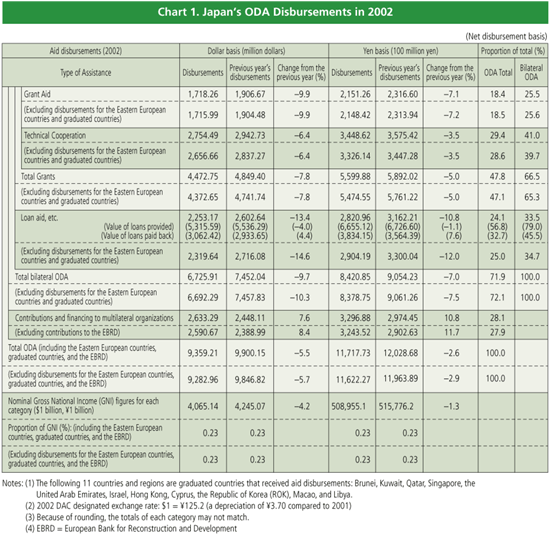 |
Breaking down bilateral ODA by type of assistance, looking at grants, grant
aid was approximately $1.72 billion (approximately 25.6% of total bilateral
ODA), a 9.9% decrease from the previous year, and technical cooperation was
approximately $2.66 billion (approximately 39.7% of total bilateral ODA), a
6.4% decrease from the previous year. Loan aid, etc. was approximately $2.32
billion (approximately 34.7% of total bilateral ODA), a 14.6% decrease from
the previous year. Each of these various types of assistance has its own special
characteristics and Japan employs them all in a balanced manner, taking into
account conditions and assistance needs of the recipient country. Since Japan
has traditionally been implementing assistance which places importance on human
resource development and development of institutions through technical cooperation,
despite the decline in ODA budget, the reduction in the technical cooperation
budget has been smaller than the reduction in Japan’s ODA loans and grant
aid.
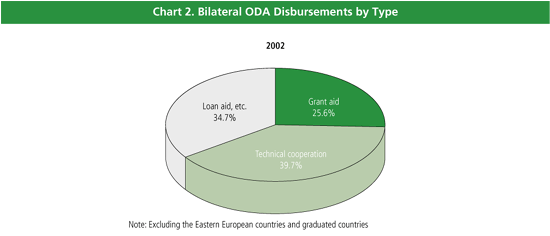 |
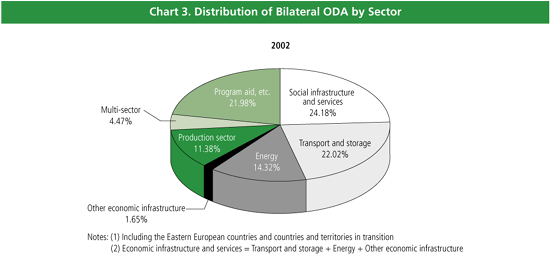 |
Breaking down bilateral ODA by sector, economic infrastructure and services
occupies the largest proportion (38.0%), followed by social infrastructure and
services (24.2%). These two sectors make up more than half of all the bilateral
ODA. Japan has traditionally utilized financial assistance to actively develop
economic infrastructure but this does not mean that Japan places importance
only on economic infrastructure. If disbursements are compared in terms of monetary
value, the expenditure on this sector appears large but if they are looked at
from the perspective of the number of projects and the human resources being
invested, they look quite different. Taking into account the increased momentum
in recent years within the international community of direct support for poverty
issues, the Government of Japan is strengthening support for the social sector,
including health and education, and is implementing ODA with a focus on support
for both the economic and social sectors.
Looking at bilateral ODA disbursements by region, assistance for the Asian region
was approximately $4.09 billion, a 3.2% decrease from the previous year and
approximately 60.7% of total bilateral ODA, assistance for Africa was approximately
$584 million, a 31.4% decrease from the previous year (8.7% of total bilateral
ODA), assistance for the Middle East was approximately $208 million, a 27.3%
decrease from the previous year (3.1% of total bilateral ODA), and assistance
for Oceania was approximately $93 million, a 7.9% decrease from the previous
year (1.4% of total bilateral ODA). As stated above, approximately 60% of Japan’s
bilateral ODA is being directed to the Asian region. Looking at the long historical
span, the tendency of economic cooperation allocations to give priority to Asia
has been gradually weakening against a background of changes in assistance needs,
etc. in recent years led by the development of the Asian region. Nevertheless,
Japan continuously to provides the majority of its assistance to the Asian region,
with which it has a deep relationship.
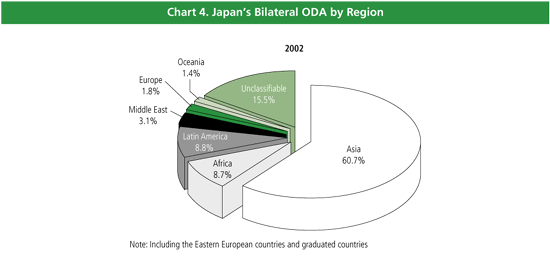 |
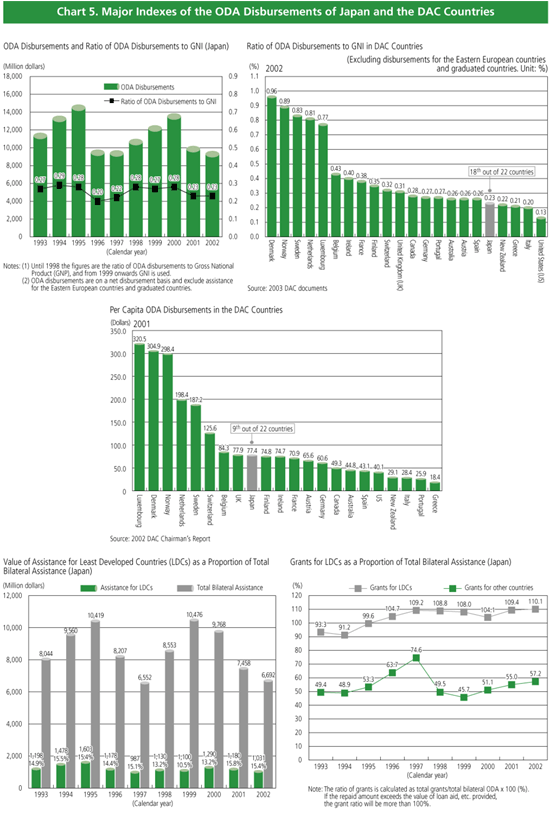 |
Previous Page | Next Page






